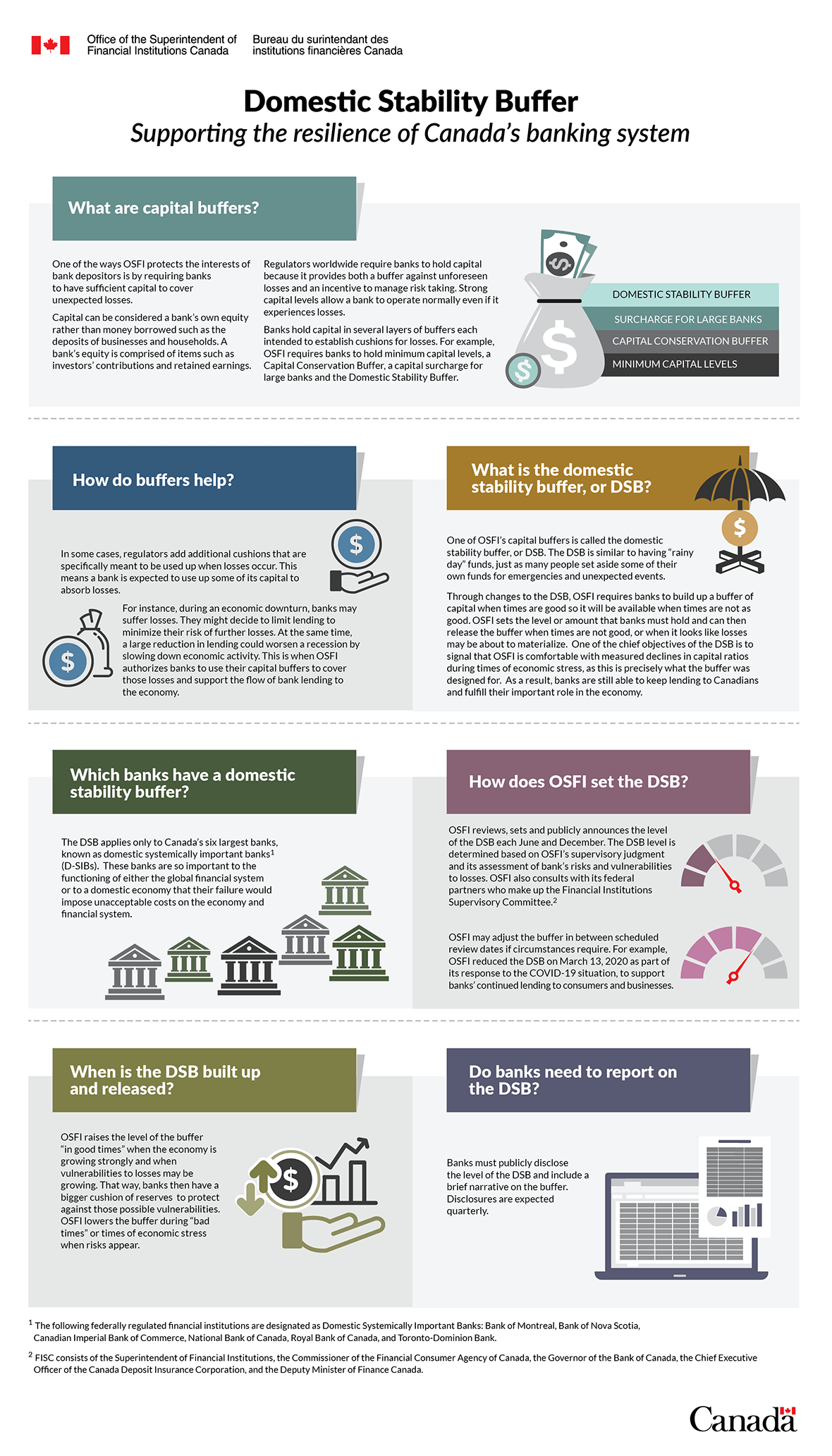Domestic Stability Buffer – Supporting the resilience of Canada’s banking system

Description: Domestic Stability Buffer – Supporting the resilience of Canada’s banking system
What are capital buffers?
One of the ways OSFI protects the interests of bank depositors is by requiring banks to have sufficient capital to cover unexpected losses. Capital can be considered a bank's own equity rather than money borrowed such as the deposits of businesses and households. A bank's equity is comprised of items such as investors' contributions and retained earnings.
Regulators worldwide require banks to hold capital because it provides both a buffer against unforeseen losses and an incentive to manage risk taking. Strong capital levels allow a bank to operate normally even if it experiences losses.
Banks hold capital in several layers of buffers each intended to establish cushions for losses. For example, OSFI requires banks to hold minimum capital levels, a Capital Conservation Buffer, a capital surcharge for large banks and the Domestic Stability Buffer.
How do buffers help?
In some cases, regulators add additional cushions that are specifically meant to be used up when losses occur. This means a bank is expected to use up some of its capital to absorb losses. For instance, during an economic downturn, banks may suffer losses. They might decide to limit lending to minimize their risk of further losses. At the same time, a large reduction in lending could worsen a recession by slowing down economic activity. This is when OSFI authorizes? banks to use their capital buffers to cover those losses and support the flow of bank lending to the economy.
What is the domestic stability buffer?
One of OSFI's capital buffers is called the domestic stability buffer, or DSB. The DSB is similar to having "rainy day" funds, just as many people set aside some of their own funds for emergencies and unexpected events.
Through changes to the DSB, OSFI requires banks to build up a buffer of capital when times are good so it will be available when times are not as good. OSFI sets the level or amount that banks must hold and can then release the buffer when times are not good, or when it looks like losses may be about to materialize. One of the chief objectives of the DSB is to signal that OSFI is comfortable with measured declines in capital ratios during times of economic stress, as this is precisely what the buffer was designed for. As a result, banks are still able to keep lending to Canadians and fulfill their important role in the economy.
Which banks have a domestic stability buffer?
The DSB applies only to Canada's six largest banks, known as domestic systemically important banks (D-SIBs).
How does OSFI set the buffer?
OSFI reviews, sets and publicly announces the level of the DSB each June and December. The DSB level is determined based on OSFI's supervisory judgment and its assessment of bank's risks and vulnerabilities to losses. OSFI also consults with its federal partners who make up the Financial Institutions Supervisory Committee.
OSFI may adjust the buffer in between scheduled review dates if circumstances require. For example, OSFI reduced the DSB on March 13, 2020 as part of its response to the COVID-19 situation, to support banks' continued lending to consumers and businesses.
When is the buffer built up and released?
OSFI raises the level of the buffer "in good times" when the economy is growing strongly and when vulnerabilities to losses may be growing. That way, banks then have a bigger cushion of reserves to protect against those possible vulnerabilities. OSFI lowers the buffer during "bad times" or times of economic stress when risks appear.
Do banks need report on the DSB?
Banks must publicly disclose the level of the DSB and include a brief narrative on the buffer. Disclosures are expected quarterly.